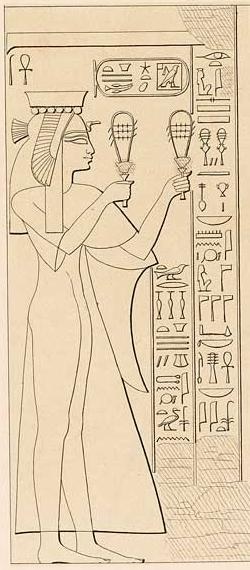
King Doayd (David) (1057-1018 BCE) was contemporary with a pharaoh of the Egyptian 21st Dynasty in the 11th century BCE whose wife was named Tha-kha-Panays (תחפניס) according to 1 Kings 11:19. European scholars don’t have a clue who this woman is and that is because this is not their book and they have no business colonizing the world with their views about a book they did not author and does not belong to them.
For the Egyptian queen’s name to be mentioned in 1 Kings but not the name of her royal husband means she had to have been an extremely important figure in her day, more significant even than her husband the pharaoh. In the 11th century BCE there is only queen in Egypt whose resume and V.I.P. status rivaled that of her own royal husband.
The Theban high-priest of the dumbass god Amun named Pinedjem I was able to become a legitimate pharaoh because he was married to a woman of extremely high status based on the string of elaborate titles attributed to her which included King’s Daughter; King’s Wife; King’s Mother; Lady of the Two Lands; Mistress of the Two Lands; Daughter of the Great Royal Wife; Foremost Singer of Amun; Mother of the Great Royal Wife; Mother of the High Priest of Amun; and Mother of Generalissimo.
European Egyptologists assume she was probably the daughter of pharaoh Ramesses XI (1108-1073 BCE), the last king of the Egyptian 20th Dynasty, or maybe the daughter of pharaoh Smendes (1072-1047 BCE), the first king of the Egyptian 21st Dynasty. They simply do not know. They also assume that her birth name was Hent-tawy, (ḥnw.t-t3.wỉ, “Mistress of the Two Lands [=Egypt]”), but this assumption is weak since Hent-tawy was an appellative borne by queens in ancient Egypt and the daughter of pharaoh Ramesses II (1275-1210 BCE) was the first of several royal ladies to have it as a personal name. Thus, it is doubtful that Pinedjem I’s wife was given the appellative at birth and more likely that she assumed it as her official name after she rose to prominence. But who was her father and what was her real name at birth?
The biblical name Tha-kha-Panays contains the name Panehsy (p3-nḥsỉ, “The Nubian”) in it as clear as day and this is the clue to identifying her. For the etymology of the name Panehsy, see Hermann Ranke: Die ägyptische Persönennamen. Verlag von J. J. Augustin in Glückstadt, 1935. p.113. Panehsy was the Viceroy of Kush during the reign of Ramesses XI. He fell out of favor with Ramesses XI at some point due to his “transgression against the High Priest” Amenhotep and he was driven out of Thebes, but he appears to have remained at his post as Viceroy of Kush in Nubia until his death.
The name Tha-kha-Panays stands for t3.ḥn(.t)-p3-nḥsỉ, “She Whom Panehsy Protects” (with dissimilation of the first n in the word ḥn[.t]), i.e. the daughter of Panehsy. For other Egyptian names of this same formation from the period of the Egyptian 21st Dynasty, see again Hermann Ranke, op. cit., p. 365: 24 f. Tha-kha-Panays would have become a “King’s Daughter” after her real father Panehsy was chased out of Thebes leaving his family members behind, and Ramesses XI and his queen subsequently adopted her as their own daughter. It would have been Ramesses XI who gave her the new name “Hent-tawy,” re-naming her after the daughter of his great namesake Ramesses II. He also gave her the title “Daughter of the Great Royal Wife.” In private she was known by her birth name Tha-kha-Panays, but in all official records and documentation she was known as Hent-tawy.
The “daughter” of Ramesses XI was her husband Pinedjem I’s claim to fame. Without her Pinedjem I would not have been able to cement the relations with the other powerful families of the period that were necessary in order to become a pharaoh. This is why she is mentioned explicity in 1 Kings by her birth name and the name of her royal husband goes unmentioned. He wasn’t the rock star. She was: the biological daughter of the Viceroy of Kush Panehsy; the adopted daughter of pharaoh Ramesses XI and his Great Royal Wife; the wife of Theban high-priest Pinedjem I who became pharaoh Pinedjem I (thanks to her); and the mother of pharaoh Psusennes I (1046-1001 BCE).
When King Doayd and his commander Ya’oh-ab (Joab) slaughtered every single male of Adom (Edom) the sole survivor, Adad (Hadad), escaped and managed to make it to Egypt in safety. The only route open to Adad was the one from Midian down thru Paran to the Gulf of Aqaba and from thence by ferry over to the Red Sea shore in Upper Egypt. In other words, Adad fled to the Theban region which was being ruled at that time by pharaoh Pinedjem I. Adad married the sister of Pinedjem I’s wife Tha-kha-Panays and she gave birth to Adad’s son. Tha-kha-Panays then had her nephew weaned as one of pharaoh’s sons, i.e. an adopted son (1 Kgs 11:15-20). Makes perfect sense. Tha-kha-Panays was herself adopted by a royal couple, a pharaoh and his wife, and now she is seeing to it that her nephew is adopted by another royal couple, her husband the pharaoh and herself. Adad presumably left his son behind in Egypt when he requested leave to return to his own land. The Adomay (Edomite) bloodline would not exist were it not for Adad having survived the genocide of King Doayd.
How can the biblical account of King Doayd be phony and written centuries after the fact when it is confirmed by the names and by the careers of people who are attested in the Egyptian historical record (and on the walls!) during the very period that the book says King Doayd lived? How is Doayd a myth when Aramaean kings in the 9th century BCE mention him by name in their Old Aramaic inscriptions during their wars against Doayd’s royal sons? He’s a real historical figure, like or not. You’ll just have to learn to deal with it and come to terms with reality and with the evidence.
The problem with us OMPP is that we have been letting heathen strangers act as the authority with the right to tell us who we are, where we come from, and what our own book means and whether or not the book is valid. Not anymore. Never again in fact. We are not slaves any longer. We can do our own research about our past and reach our own conclusions. We are commanded to ask not to strangers but to our Maker concerning His sons (Yashai-Ya’oh 45:11). Our Maker has a name.
His name is YA’OH
Always has been. Always will be.
#EXODUS2023
1.15.7252

“Thakhapanys” oh even though it’s Egyptian it is a very attractive name to me😆
Aman wa aman khazak lacha Mabayn🙏🏽
aman